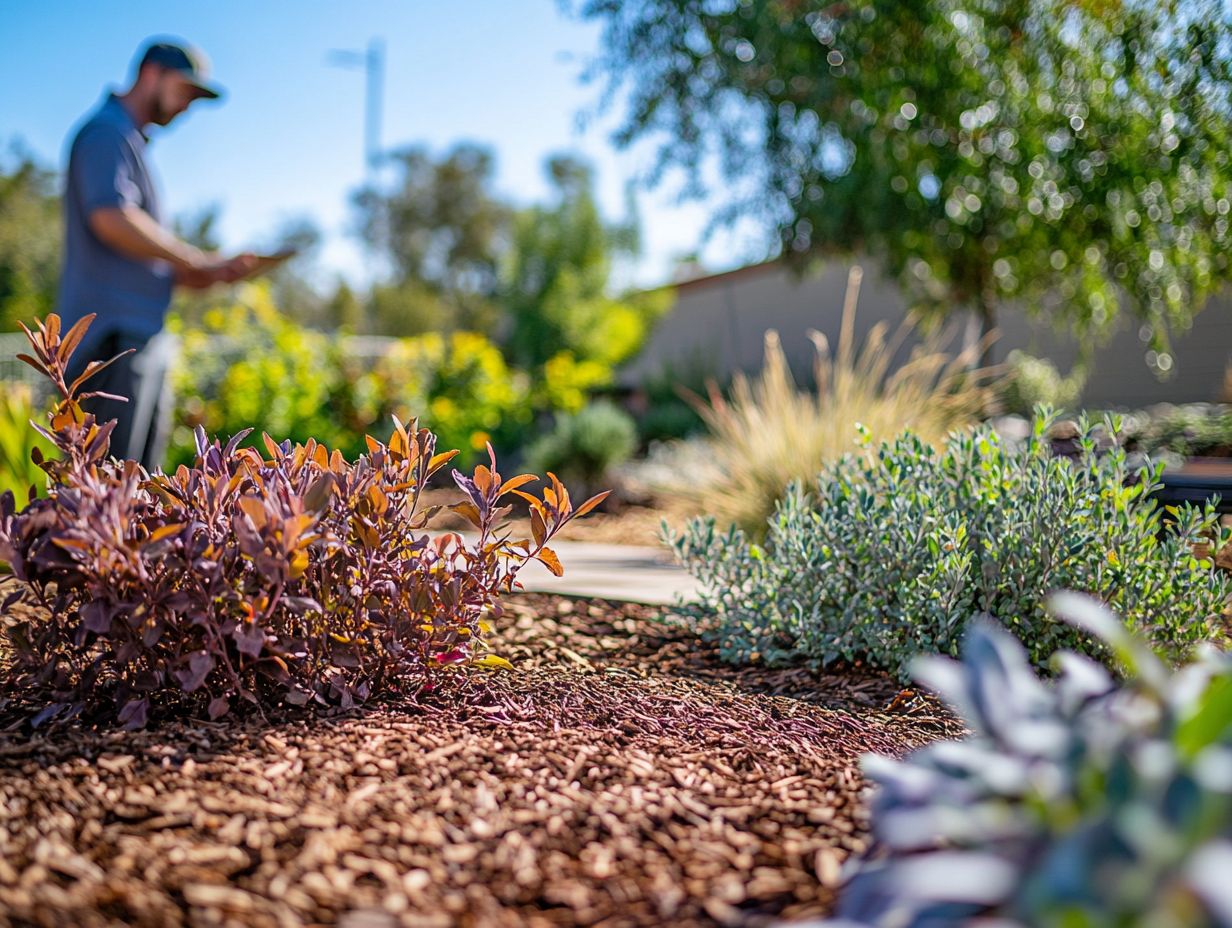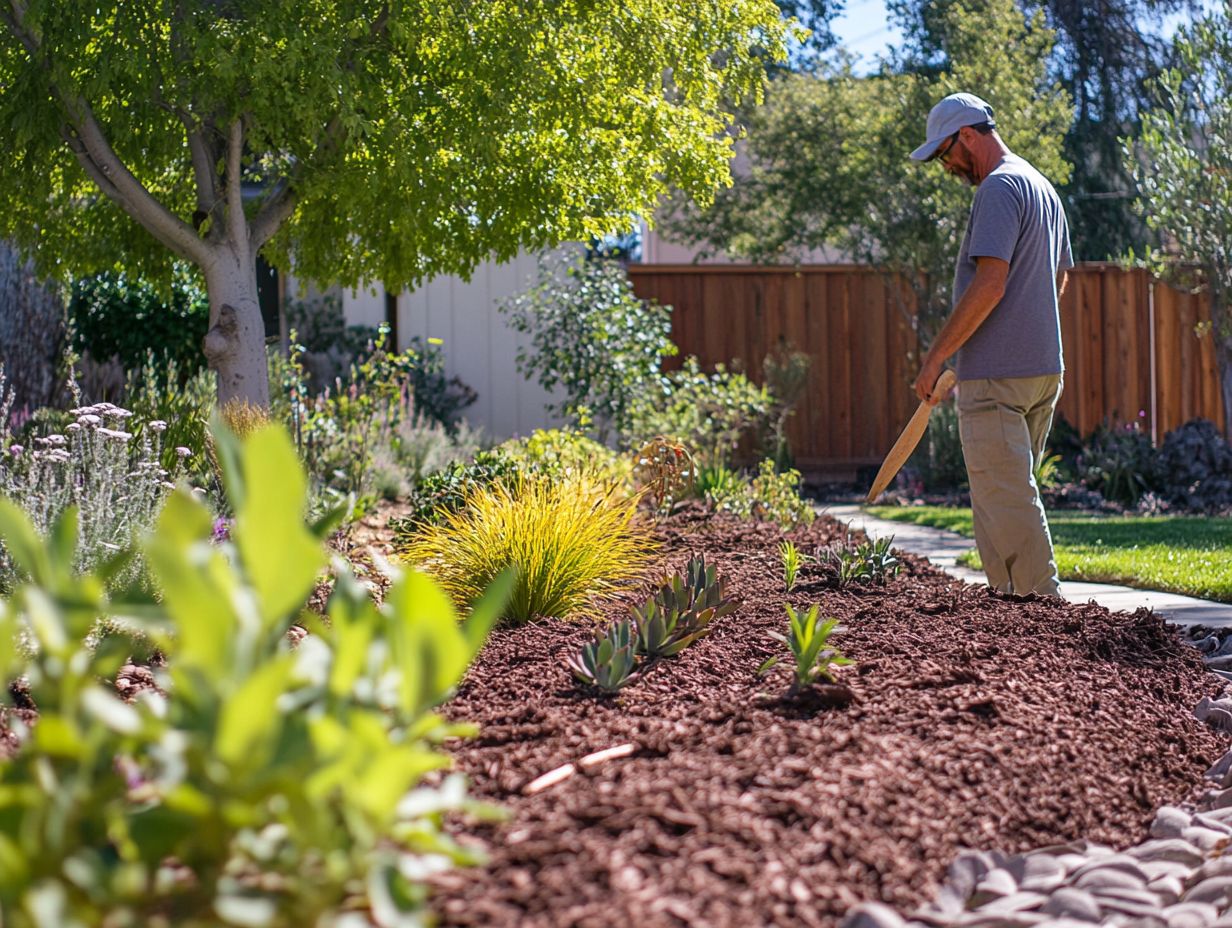Selecting Suitable Mulch for Drought Plants
Drought plants are truly remarkable survivors, expertly adapted to flourish in dry conditions where many other plants struggle.
Understanding their specific needs is essential for successful gardening in arid climates. This article delves into the importance of mulching for drought plants, showcasing its numerous benefits and the various types available.
Get ready to discover the exciting secrets to thriving with these resilient plants!
Contents
- Key Takeaways:
- Understanding Drought Plants
- Importance of Mulching for Drought Plants
- Types of Mulch for Drought Plants
- Factors to Consider When Choosing Mulch
- Tips for Applying Mulch to Drought Plants
- Mulching Mistakes to Avoid
- Frequently Asked Questions
- What is mulch and why is it important for drought and native plants?
- What factors should I consider when selecting suitable mulch for drought plants?
- What are suitable types of mulch for drought plants?
- How thick should I apply mulch for drought plants?
- Can I use any type of mulch for drought plants?
- When is the best time to apply mulch for drought plants?
Key Takeaways:

- Drought plants have unique characteristics and require specific care, including proper mulching.
- Mulching offers numerous benefits for drought plants, such as conserving moisture and regulating soil temperature.
- When selecting mulch for drought plants, consider factors like climate, soil conditions, and the plants’ needs and preferences.
Understanding Drought Plants
Understanding drought-tolerant plants is essential for effective landscape management, particularly in the face of climate change’s ongoing impact on our environment. These plants, often native to arid regions, have developed remarkable adaptations to thrive with minimal water.
By incorporating drought-tolerant species into your landscape design, you not only enhance biodiversity which means having a variety of different types of plants and animals but also actively contribute to water conservation efforts.
Selecting the right plants such as succulents and those well-suited for dry gardens gives you the power to create vibrant planting beds that flourish even in the harshest conditions.
What are Drought Plants?
Drought plants are your best allies when it comes to thriving in low-water environments, making them perfect for dry gardens and sustainable landscape designs.
These hardy species, like succulents, cacti, and native grasses, boast impressive adaptations such as deep root systems and fleshy leaves that efficiently store moisture. Take the agave and various sedums as examples; they not only flourish with minimal water but also bring a delightful array of colors and textures that enhance your garden’s visual appeal.
By incorporating these plants into your landscape, you ll significantly boost water conservation efforts, which is essential in today s climate change landscape. Their ability to thrive in arid conditions offers both aesthetic charm and ecological benefits, attracting pollinators while keeping maintenance to a minimum.
Importance of Mulching for Drought Plants
Mulching is a critical practice for elevating the growth and health of drought-tolerant plants. It provides an array of benefits that bolster their survival in arid environments.
Applying mulch markedly enhances moisture retention in the soil an essential factor for the vitality of drought-resistant species. It also helps regulate soil temperature, curtails weed proliferation, and fosters improved plant growth. Familiarizing yourself with the various mulch options and their suitability for different plants is key to achieving remarkable gardening success.
Benefits of Mulching
Mulching presents an array of benefits that you won’t want to overlook. It includes improved moisture retention, weed prevention, and enhanced soil structure all crucial elements for successfully cultivating drought-resistant plants.
If you’re considering drought-tolerant options, applying a generous layer of mulch can work wonders. It drastically reduces evaporation rates, ensuring that the soil remains moist for extended periods. Organic mulches, like wood chips and straw, not only keep pesky weeds at bay but also break down over time, enriching the soil with essential nutrients.
Inorganic choices such as gravel or rubber can effectively manage heat and prevent soil compaction. By thoughtfully selecting the right mulch materials, you can greatly enhance water conservation, lessen maintenance efforts, and create a flourishing ecosystem that s perfect for drought-tolerant species.
Types of Mulch for Drought Plants

When selecting the ideal mulch for drought-tolerant plants, it is crucial to understand the various types of mulch available and the role of mulch in drought gardening to maintain a thriving garden.
Organic mulches, such as shredded bark, compost, and straw, enrich the soil as they break down. They enhance soil fertility and the way the soil is arranged over time.
In contrast, inorganic mulches like rocks and gravel provide a durable solution for retaining moisture while effectively reducing weed growth. These mulches are perfect for creating a sustainable garden, ensuring your plants thrive even in challenging conditions.
Organic Mulches
Organic mulches, like compost and shredded bark, are natural materials that enhance the soil as they decompose. This makes them ideal for promoting plant growth in drought-prone regions.
These mulches improve soil structure and aeration, playing an important role in moisture retention, which is essential for keeping your plants healthy during dry spells.
Other organic options, like straw, grass clippings, and wood chips, offer various benefits, including temperature regulation and weed suppression. As these materials break down, they release vital nutrients back into the soil, enhancing its fertility over time.
By incorporating organic mulches into your gardening practices, you can cultivate a more resilient and productive garden environment, leading to healthier plants and a more vibrant landscape.
Inorganic Mulches
Inorganic mulches, such as rocks and gravel, provide a robust solution for retaining soil moisture while minimizing weed growth. They are an ideal choice for drought gardens.
Their application conserves water and elevates your landscape’s aesthetic, showcasing a delightful array of colors and textures. Unlike organic mulches that decompose and require regular replacement, inorganic alternatives last for years without significant degradation.
This durability means less maintenance and lower long-term costs, allowing you to focus more on the beauty and functionality of your green spaces.
Inorganic mulches also help regulate soil temperature and can act as a deterrent for pests, enhancing the overall environmental resilience of your garden.
Factors to Consider When Choosing Mulch
When selecting the best mulch for your drought-tolerant plants, it is essential to consider several factors, including climate, soil conditions, and the specific needs of each plant. Understanding the benefits of mulching in drought gardening can also help you make the right choice.
By assessing the unique environmental characteristics of your gardening space, you can choose mulch that promotes moisture retention and prevents weeds, ultimately protecting your plants’ health. Remember, different species may have distinct preferences regarding mulch depth and materials. Aligning your choices with these requirements will enhance their effectiveness and overall vitality.
Climate and Soil Conditions
Understanding your local climate and soil conditions is crucial when applying mulch, as these factors greatly impact the success of your gardening efforts.
For instance, in hot and arid regions, a thicker layer of mulch can work wonders for moisture retention. In cooler areas, a lighter application can be beneficial, preventing soil compaction and allowing warmth to penetrate and reach the roots.
If you have sandy soils that drain quickly, consider using organic mulches like wood chips. They break down over time and improve soil structure. In contrast, clay soils may require different mulching materials that promote better aeration.
By selecting the right mulch tailored to your specific environment, you can enhance plant health, minimize weed growth, and cultivate a vibrant and flourishing garden.
Start mulching now for a healthier, more beautiful garden!
Plant Needs and Preferences

Assessing the specific needs and preferences of your drought plants is essential for determining the optimal mulch depth and type that will enhance their growth. Different species thrive under varying conditions, so you ll need to adopt tailored mulching strategies. For example, succulents may flourish with a lighter layer of gravel or rock mulch, which allows for adequate drainage while retaining warmth. In contrast, drought-resistant shrubs might benefit from a thicker layer of organic mulch, like wood chips or bark, to conserve moisture and suppress weeds.
Understanding the unique requirements of each plant promotes healthier root development and minimizes competition for nutrients. This ultimately leads to a more resilient garden ecosystem. Think carefully about the mulch depth and materials to significantly elevate the success of your drought-tolerant landscaping efforts.
Tips for Applying Mulch to Drought Plants
Applying mulch correctly is essential to maximizing its benefits for drought-resistant plants. Here are several effective mulching tips to elevate your gardening techniques:
- Select the best mulch tailored to your specific plant needs.
- Determine the ideal depth for application.
- Layer your mulch effectively to enhance soil moisture retention, prevent weeds, and foster healthier plant growth.
By adhering to these practices, you can boost your garden s strength against drought today and mitigate the effects of climate change.
Proper Mulching Techniques
Employing proper mulching techniques is essential for maximizing moisture retention and ensuring optimal growth for your drought-resistant plants while enhancing your landscape design.
Using organic materials like shredded leaves or wood chips significantly enhances soil health. Aim for a mulch depth of two to four inches to effectively suppress weeds while allowing water to penetrate the soil.
Consider utilizing mulch layering methods, such as placing larger materials at the bottom to create a thicker base, improving both drainage and aeration while optimizing soil structure.
Remember to keep the mulch a few inches away from the stems of your drought-resistant plants to prevent rot. This careful attention will help ensure they thrive, even under challenging conditions.
Mulching Mistakes to Avoid
Avoiding common mulching mistakes is essential for preserving the health of your drought-resistant plants and maximizing your gardening efforts, particularly in summer gardening.
- Applying mulch too thickly.
- Failing to establish proper mulch layers.
- Neglecting moisture retention, which can lead to stunted plant growth and challenges in garden maintenance.
By recognizing these pitfalls and adhering to sound gardening principles, you can refine your mulch application for optimal results.
Common Mistakes and How to Avoid Them
Common mistakes in mulch application can harm the health and growth of your drought-resistant plants. With a bit of awareness and the right techniques, you can sidestep these pitfalls:
- Choosing the wrong type of mulch.
- Applying it at an incorrect depth.
- Placing it too close to plant stems, leading to moisture retention issues and hindering nutrient absorption.
Understanding the best practices for mulch application ensures it fulfills its intended purpose effectively. Opt for organic materials such as wood chips, leaves, or straw to enhance soil structure while maintaining a 2-4 inch layer to help regulate temperature and moisture levels. Proper placement is key; keeping mulch away from the bases of plants prevents rot and disease, ultimately promoting healthier growth for your drought-tolerant varieties and contributing to effective landscape management.
Frequently Asked Questions

What is mulch and why is it important for drought and native plants?
Mulch is a layer of material placed on top of the soil around plants. It helps conserve moisture, regulate soil temperature, stop weeds from growing, and add nutrients to the soil.
What factors should I consider when selecting suitable mulch for drought plants?
Consider the type of plant, climate, and soil type. Choosing the right mulch can make a significant impact on your plants’ health.
What are suitable types of mulch for drought plants?
Suitable types of mulch for drought plants include organic options like wood chips, straw, compost, and shredded leaves. You can also use inorganic materials like gravel, stones, and plastic sheeting to conserve moisture.
How thick should I apply mulch for drought plants?
Apply mulch with a thickness of 2-4 inches. This coverage will help retain moisture and keep weeds at bay without suffocating your plants.
Can I use any type of mulch for drought plants?
No, not all mulches work for drought plants. Avoid those that retain too much moisture and can lead to root rot, like thick bark or wood chips.
When is the best time to apply mulch for drought plants?
Apply mulch in the spring, after the soil warms up, to retain moisture as temperatures rise. Fall is also a good time to insulate the soil during winter.






